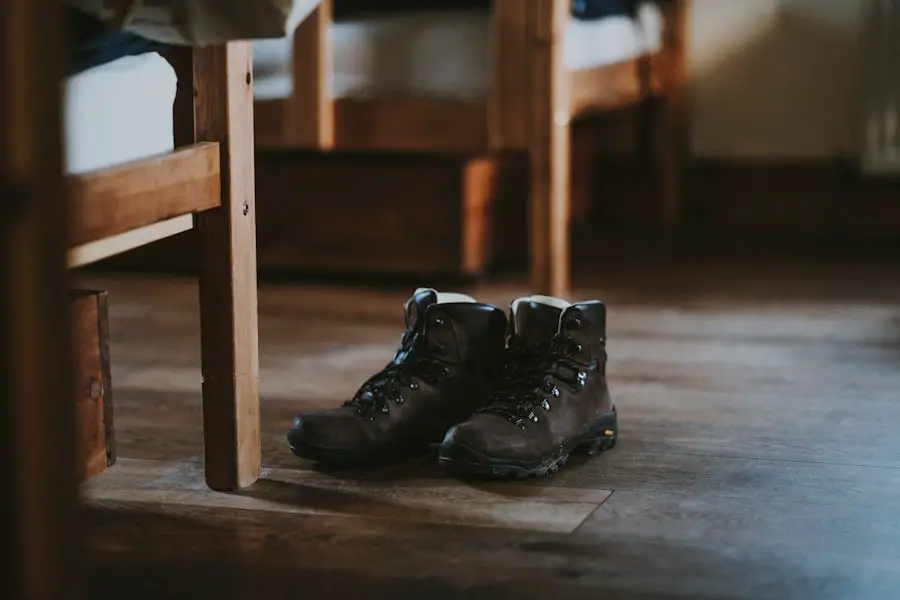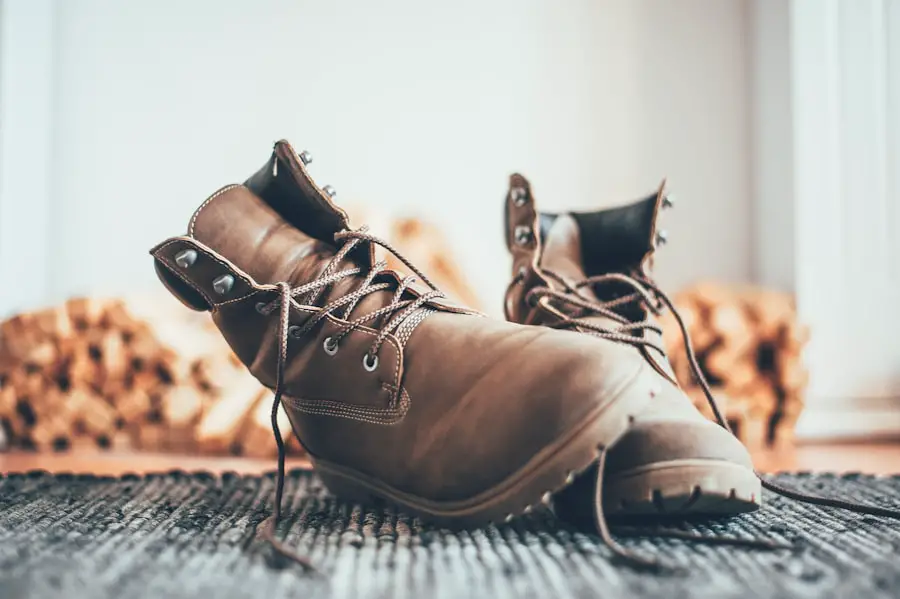Selecting the appropriate hiking boots is a critical decision that can significantly impact your outdoor experience. The right pair of boots not only provides comfort but also ensures safety on various terrains. When choosing hiking boots, consider the type of hiking you plan to do.
For instance, if you are embarking on a multi-day backpacking trip, you may want to invest in a sturdy pair of boots that offer excellent ankle support and durability. Look for features such as waterproof materials, breathable linings, and rugged outsoles designed for traction on slippery or uneven surfaces. Brands like Merrell, Salomon, and Vasque offer a range of options tailored to different hiking conditions.
Fit is paramount when it comes to hiking boots. A well-fitted boot should feel snug but not overly tight, allowing for some wiggle room for your toes. It’s advisable to try on boots at the end of the day when your feet are slightly swollen, mimicking the conditions you’ll experience on the trail.
Additionally, consider the type of socks you will wear; thicker socks may require a half-size larger boot. Pay attention to the break-in period as well; new boots should be worn on shorter hikes before tackling more challenging trails to avoid blisters and discomfort.
Key Takeaways
- Choose hiking boots with good ankle support and a sturdy sole for stability on the trail.
- Layer clothing for comfort and protection, including moisture-wicking base layers and waterproof outer layers.
- Find a backpack with adjustable straps and multiple compartments to fit your specific needs.
- Use navigation tools such as a map, compass, and GPS device to stay on course during your hike.
- Stay hydrated with a water bottle or hydration pack, and consider water purification methods for longer hikes.
Clothing: Layering for Comfort and Protection
When it comes to outdoor activities, the right clothing can make all the difference in ensuring comfort and protection from the elements. Layering is a fundamental principle in outdoor clothing, allowing you to adapt to changing weather conditions while maintaining body temperature. The base layer is crucial as it sits directly against your skin, wicking moisture away to keep you dry.
Fabrics such as merino wool or synthetic materials like polyester are excellent choices for base layers due to their moisture-wicking properties and ability to regulate temperature. The middle layer serves as insulation, trapping heat while still allowing moisture to escape. Fleece jackets or down vests are popular options for this layer, providing warmth without excessive bulk.
Finally, the outer layer acts as a barrier against wind and rain. Look for waterproof and breathable jackets made from materials like Gore-Tex or similar technologies that keep you dry while allowing sweat to evaporate. It’s also wise to consider the versatility of your clothing; items that can be easily layered or removed will give you greater flexibility in adapting to changing conditions throughout your hike.
Backpacks: Finding the Ideal Pack for Your Needs

Choosing the right backpack is essential for any hiking adventure, as it directly affects your comfort and efficiency on the trail. The first step in selecting a backpack is determining its capacity, which is typically measured in liters. Day hikes usually require packs ranging from 20 to 30 liters, while multi-day trips may necessitate larger packs of 50 liters or more.
Consider what gear you will carry; a well-organized pack with multiple compartments can help distribute weight evenly and provide easy access to essentials. Fit is another critical factor when selecting a backpack. A properly fitted pack should sit comfortably on your hips and shoulders without causing pressure points.
Many brands offer adjustable suspension systems that allow you to customize the fit based on your torso length.
Hydration reservoirs or external pockets for water bottles can also enhance convenience, ensuring you stay hydrated without rummaging through your pack.
Navigation: Tools for Finding Your Way on the Trail
| Navigation Tools | Benefits |
|---|---|
| Map and Compass | Reliable and doesn’t require batteries |
| GPS Device | Provides accurate location and tracking |
| Trail Markers | Easy to follow and identify the trail |
| Smartphone Apps | Convenient and offer various features |
Navigating through unfamiliar terrain can be daunting without the right tools at your disposal. Traditional maps and compasses remain invaluable resources for hikers who prefer a hands-on approach to navigation. A topographic map provides detailed information about elevation changes, terrain features, and potential hazards along your route.
Learning how to read these maps effectively is essential; understanding contour lines and symbols can help you anticipate challenges ahead. In addition to traditional navigation tools, modern technology has introduced GPS devices and smartphone applications that can enhance your hiking experience. GPS devices are designed specifically for outdoor use, often featuring preloaded maps and waypoints that can guide you along established trails.
Smartphone apps like AllTrails or Gaia GPS offer similar functionalities, allowing users to download maps for offline use and track their progress in real-time. However, it’s crucial to remember that technology can fail; always carry a backup navigation method in case of battery depletion or signal loss.
Hydration: Staying Safe and Healthy with the Right Water Gear
Proper hydration is vital during any hiking expedition, as even mild dehydration can lead to fatigue and decreased performance. Carrying enough water is essential, but so is having the right gear to ensure you stay hydrated throughout your journey. Hydration packs are an excellent option for hikers who prefer hands-free drinking; these packs come equipped with a reservoir and a tube that allows you to sip water without stopping.
They are particularly useful on long hikes where frequent stops may not be feasible. For those who prefer traditional water bottles, consider using insulated bottles that keep water cold for hours, enhancing your overall hydration experience. Additionally, it’s wise to plan your water sources along the trail; knowing where streams or lakes are located can help you refill your supply if necessary.
Water purification methods such as filters or chemical tablets are essential if you plan to source water from natural bodies; these tools ensure that you avoid harmful pathogens that could lead to illness.
Nutrition: Packing the Right Snacks and Meals for Energy

Snacking for Sustained Energy
Nutrition plays a crucial role in maintaining energy levels during hikes, making it essential to pack the right snacks and meals. High-energy foods that are lightweight and easy to carry are ideal for outdoor adventures. Trail mix, which typically combines nuts, dried fruits, and sometimes chocolate or granola, offers a perfect balance of carbohydrates, protein, and healthy fats that provide sustained energy without weighing you down.
Meal Preparation for Longer Trips
For longer hikes or multi-day trips, consider preparing meals in advance that can be easily cooked on portable stoves or over campfires. Dehydrated meals are popular among backpackers due to their lightweight nature; simply add hot water to rehydrate them before consumption.
Energy Bars: A Convenient Snack
Additionally, energy bars can serve as convenient snacks that provide quick bursts of energy when needed. Look for bars with natural ingredients and minimal added sugars to ensure they provide lasting fuel without causing energy crashes.
Safety: Essential First Aid and Emergency Supplies
Safety should always be a top priority when venturing into the wilderness, making it essential to carry a well-stocked first aid kit and emergency supplies. A basic first aid kit should include items such as adhesive bandages, antiseptic wipes, gauze pads, adhesive tape, pain relievers, and any personal medications you may need. Familiarize yourself with how to use each item in your kit; knowing how to treat common injuries like cuts, scrapes, or sprains can make a significant difference in an emergency situation.
In addition to first aid supplies, consider carrying emergency gear such as a whistle, signal mirror, or emergency blanket. A whistle can be invaluable for signaling for help if you become lost or injured; its sound carries much farther than your voice alone. An emergency blanket provides warmth in case of unexpected weather changes or if someone becomes hypothermic.
It’s also wise to have a multi-tool or knife on hand; these versatile tools can assist with various tasks from food preparation to gear repairs.
Extras: Must-Have Gear for Comfort and Convenience
While the essentials are crucial for any hiking trip, certain extras can enhance your overall comfort and convenience on the trail. A good pair of trekking poles can provide stability and reduce strain on your joints during steep ascents or descents. They help distribute weight more evenly and can be particularly beneficial when navigating rocky or uneven terrain.
Another valuable addition is a portable camp chair or lightweight seating option; taking breaks becomes much more enjoyable when you have a comfortable place to rest. Additionally, consider packing a lightweight tarp or groundsheet; this versatile piece of gear can serve multiple purposes such as providing shelter from rain or creating a clean area for cooking or resting. Lastly, don’t overlook personal items like sunscreen and insect repellent; protecting yourself from sunburn and bug bites can significantly improve your outdoor experience.
By carefully considering each aspect of your hiking gear—from footwear and clothing to navigation tools and safety supplies—you can ensure a successful and enjoyable adventure in nature’s embrace.
If you’re planning a hiking trip this spring, you may also want to check out this article on 5 Amazing Tent Camping Spots Near You This Spring 2025. It can provide you with some great options for where to stay during your outdoor adventure.
FAQs
What are the essential items for hiking?
Some essential items for hiking include a sturdy pair of hiking boots, a backpack, water bottles or a hydration system, a map and compass, a first aid kit, a multi-tool or knife, and appropriate clothing for the weather.
What type of clothing is best for hiking?
Clothing for hiking should be moisture-wicking and quick-drying to keep you comfortable. It’s also important to dress in layers, including a base layer, insulating layer, and outer shell. Additionally, wearing proper socks and a hat can help protect you from blisters and sun exposure.
What kind of backpack is suitable for hiking?
A suitable backpack for hiking should be comfortable to wear and have enough capacity to carry all your essentials. Look for a backpack with padded shoulder straps, a hip belt for weight distribution, and multiple compartments for organization.
Why is it important to bring a map and compass when hiking?
A map and compass are important for navigation when hiking, especially in areas without cell phone reception. They can help you stay on the right trail and find your way back if you get lost.
What should I include in a first aid kit for hiking?
A first aid kit for hiking should include items such as adhesive bandages, gauze pads, adhesive tape, antiseptic wipes, blister treatment, pain relievers, and any personal medications. It’s important to customize your first aid kit based on your specific needs and the length of your hike.
